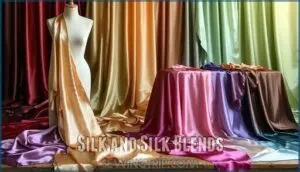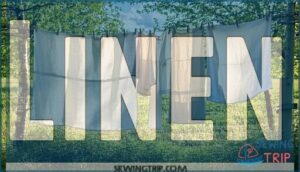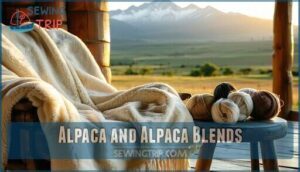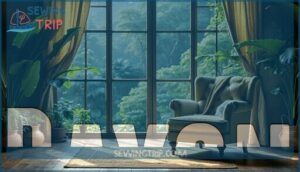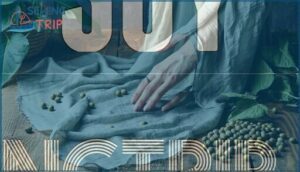This site is supported by our readers. We may earn a commission, at no cost to you, if you purchase through links.
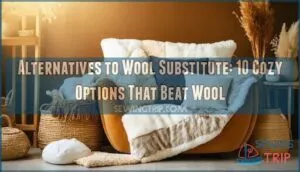
Cotton and cotton blends offer breathable comfort that’s perfect for everyday wear. Acrylic delivers wool-like warmth at a fraction of the cost.
Bamboo fabric feels silky smooth and naturally regulates temperature. Alpaca provides luxury warmth without wool’s scratchiness.
Silk brings elegance and natural temperature control. Linen keeps you cool in warmer weather. Polyester blends offer durability and easy care.
Each material has its sweet spot for different climates and occasions. The trick is matching the right fabric to your specific needs and lifestyle preferences.
Table Of Contents
Key Takeaways
- You’ll find cotton and acrylic provide excellent wool alternatives at budget-friendly prices, with cotton offering breathable comfort and acrylic delivering wool-like warmth without the cost.
- Bamboo fabric gives you natural antimicrobial properties and temperature regulation while using 50% less water than cotton production, making it an eco-friendly choice.
- You can choose alpaca for luxury warmth without wool’s scratchiness, as it’s naturally hypoallergenic and provides superior insulation while remaining lightweight.
- Synthetic options like polyester excel in moisture-wicking performance and durability, while natural fibers like silk and linen offer breathability and become more comfortable with each wash.
Cotton and Cotton Blends
Cotton breaks free from wool’s scratchy reputation with its smooth, breathable comfort. You’ll find cotton and cotton blends offer unmatched versatility for your textile projects.
These natural fibers excel in cotton weaving, creating everything from delicate fabrics to sturdy canvas. Cotton dyeing opens up endless color possibilities. The fiber absorbs dyes beautifully, giving you vibrant, long-lasting results.
Cotton spinning produces consistent yarn weights, while cotton finishing techniques enhance durability and softness. Modern cotton textiles blend seamlessly with other fibers, boosting performance without sacrificing comfort.
Cotton blends combine the best of both worlds. Mix cotton with bamboo for antibacterial properties, or blend with polyester for wrinkle resistance. These ecofriendly options reduce environmental impact compared to synthetic alternatives.
Your wallet will thank you too. Cotton costs less than premium wool while delivering similar warmth and comfort. It’s machine washable, making care simple and stress-free. When choosing cotton fabrics, consider the benefits of cotton fabric choices to make certain you select the best option for your needs.
Acrylic and Acrylic Blends
Breaking free from wool’s limitations, acrylic and acrylic blends offer synthetic comfort without the hefty price tag.
These synthetic fabrics deliver impressive acrylic durability while maintaining affordability that natural fibers can’t match.
Key Benefits of Acrylic Yarn:
- Budget-Friendly Production: Manufacturing costs stay low, making these affordable textiles accessible to everyone
- Enhanced Color Retention: Synthetic fibers hold vibrant dyes better than natural alternatives
- Easy Fiber Care: Machine washable convenience saves time and effort
Acrylic’s molecular structure provides 20-50% elongation at break, ensuring your projects withstand daily wear.
The fiber’s 1.16-1.18 g/cm³ density creates lightweight warmth that rivals wool’s insulation properties.
For eco-conscious crafters, seek fiber blends incorporating recycled materials.
These eco friendly alternatives reduce environmental impact while delivering the performance you need.
Acrylic blends combine synthetic reliability with natural fiber characteristics, creating vegan alternatives that don’t compromise on comfort or durability.
By exploring acrylic fabric blends, crafters can discover new possibilities for their projects.
Silk and Silk Blends
While acrylic offers affordability, silk brings unmatched elegance to your fabric choices.
You’ll find silk stands apart from other animal fibers with its natural sheen and smooth texture.
Silk production creates fibers that resist breaking and fraying better than wool in needle felting projects.
The protein structure gives silk its signature strength and flexibility.
You can work with pure silk or explore silk blends that combine luxury fabrics with practical benefits.
Silk textures range from smooth charmeuse to textured dupioni, each offering unique weaving possibilities.
When you blend silk with cotton or bamboo, you get hybrid textile fibers that balance cost and performance.
These natural textiles provide hypoallergenic alternatives for sensitive skin.
Silk weaving produces fabrics with excellent drape and breathability.
However, silk care requires gentle handling – hand wash in cool water and avoid direct sunlight.
Fiber blends often simplify maintenance while preserving silk’s luxurious feel.
You’ll pay more upfront, but silk’s durability makes it worthwhile for special projects.
Understanding fabric blend benefits is essential for selecting the right materials for your needs.
Linen
Your grandmother’s tablecloth probably taught you linen’s first lesson—it gets better with age.
Your favorite jeans know the secret—comfort improves with every wash and wear.
This natural textile transforms from stiff to sublime through washing and wear.
Linen fabric offers superior breathability and moisture-wicking properties, making it perfect for sustainable clothing and summer apparel.
Unlike synthetic alternatives, this eco fashion champion requires minimal water and pesticides during production.
Linen production has a lower carbon footprint reduction compared to other textile fibers.
Here’s why linen beats wool alternatives:
- Temperature regulation: Natural fibers keep you cool in heat, warm when needed
- Durability: Outlasts synthetic materials by years with proper care
- Hypoallergenic: Gentle on sensitive skin, unlike wool’s potential irritation
- Environmental impact: Uses 13 times fewer pesticides than conventional crops
- Versatility: Works beautifully in blends with bamboo fabric, Lyocell, and Modal
Bamboo and Bamboo Blends
While linen offers weight and durability, bamboo fabric presents a revolutionary approach to sustainable materials. You’ll discover this natural fiber combines comfort with environmental responsibility.
Bamboo yarn creates textiles that breathe better than cotton while offering natural antimicrobial properties. The bamboo growth cycle takes just 3-5 years, making it one of nature’s fastest renewable resources.
Ecofriendly textiles from bamboo require 50% less water than traditional cotton farming. This significant reduction in water usage is a crucial factor in the sustainability of bamboo fabric.
| Property | Bamboo Fabric | Traditional Cotton |
|---|---|---|
| Water Usage | 50% less | Standard baseline |
| Growth Cycle | 3-5 years | Annual crop |
| Antimicrobial | Natural | Chemical treatment |
| UV Protection | Built-in | Added coating |
Bamboo clothing naturally regulates temperature and wicks moisture effectively. These bamboo blends resist odors without chemical treatments. Natural fibers from bamboo provide UV protection, making them perfect for outdoor activities.
Understanding fabric blend benefits is essential when selecting materials for clothing. You’re choosing innovation that benefits both your comfort and the planet’s future, which is a key aspect of sustainable materials.
Alpaca and Alpaca Blends
When you’re searching for wool’s perfect replacement, alpaca fiber delivers exceptional warmth without the weight that drags you down.
This South American treasure creates textiles that feel like they’re floating on your skin while keeping you toasty warm.
Alpaca yarn outperforms traditional wool in softness and durability.
The fibers contain microscopic air pockets that trap heat efficiently, making alpaca insulation superior to bulky alternatives.
You’ll find alpaca knit garments surprisingly lightweight yet incredibly warm.
Felted alpaca works beautifully for crafting projects, offering workability that wool can’t match.
Alpaca textiles naturally resist odors and regulate temperature, keeping you comfortable in varying conditions.
The hypoallergenic properties make it perfect for sensitive skin.
Alpaca blends combine this premium fiber with cotton or silk, enhancing strength while maintaining luxury.
Unlike camel hair or vicuna, alpaca remains affordable while delivering comparable quality.
You’re getting premium performance without breaking your budget.
Understanding the merino wool difference is vital when choosing the best alternative to traditional wool.
Rayon
While alpaca offers natural luxury, rayon brings synthetic sophistication to your textile toolkit.
This cellulose fiber transforms wood pulp into silky-smooth fabric that rivals premium materials at budget-friendly prices.
Rayon fabric delivers exceptional drape and breathability.
The manufacturing process converts natural cellulose into versatile synthetic fibers through chemical treatment.
Modern Tencel production and lyocell manufacturing create refined versions with enhanced durability.
You’ll appreciate rayon’s hypoallergenic properties and moisture-wicking capabilities.
Unlike wool, these vegan textiles won’t trigger allergic reactions.
Plant based fabrics like rayon support cruelty free materials without compromising performance.
Here’s why rayon deserves your attention:
- Silky texture that feels luxurious against skin
- Affordable pricing compared to natural luxury fibers
- Excellent dye absorption for vibrant, lasting colors
- Breathable comfort perfect for year-round wear
- Versatile applications from clothing to home textiles
Rayon’s adaptability makes it shine across countless projects.
The choice between cotton vs rayon difference is vital for determining the best fabric for specific needs.
Polyester
Polyester breaks free from wool’s traditional hold with its practical advantages and budget-friendly price point.
This synthetic fiber delivers superior moisture wicking properties that keep you dry during workouts and daily activities.
Unlike wool, polyester won’t shrink in the wash or require special care instructions.
You’ll find polyester blends everywhere – from athletic wear to home textiles.
Microfiber options made from polyester feel incredibly soft against your skin while maintaining durability.
For eco-conscious consumers, recycled polyester (rPET) transforms plastic bottles into comfortable vegan textiles.
Synthetic materials like polyester resist wrinkles and dry quickly, making them perfect for busy lifestyles.
While synthetic fibers lack wool’s natural breathability, they excel in moisture management and affordability.
Choose polyester when you need reliable performance without breaking the bank.
It’s particularly effective in activewear where moisture wicking becomes your best friend during intense activities.
Understanding the polyester vs cotton difference is essential for selecting the right fabric for your needs.
Soy
Soy fibers consistently deliver sustainable comfort that breaks free from traditional wool constraints. This biodegradable wonder transforms discarded soybean protein into luxurious soy fabric that feels like silk against your skin.
You’ll discover soy textiles offer exceptional softness while supporting your eco-conscious lifestyle. Soysilk threads provide natural breathability and moisture-wicking properties.
The protein-based structure creates vegan fabrics that resist odors and maintain shape after washing. You can blend soy fiber with cotton or bamboo for enhanced durability.
Manufacturing soybean fabric requires less water than cotton production. The renewable protein source reduces textile waste substantially. You’ll appreciate how soy threads dye evenly, producing vibrant colors that last.
These soy protein fibers work perfectly for lightweight sweaters, scarves, and baby clothing. The hypoallergenic properties make soy textiles ideal for sensitive skin. You’re choosing innovation that protects both your comfort and the planet’s future.
When selecting fabrics, understanding fabric properties is vital for superior performance and comfort.
Cashmere
Why settle for traditional cashmere when innovative alternatives deliver superior performance? You’ll discover that camel hair and vicuna fiber offer exceptional textile luxury without compromising your values.
These premium alternatives match cashmere’s legendary fiber softness while providing enhanced durability. Modern alpaca and vicuna processing techniques create fabrics that rival traditional cashmere care requirements. You’re getting lightweight warmth with improved breathability. Mohair blends add structural integrity that pure cashmere lacks.
Consider these game-changing benefits:
- Ethical sourcing – No questionable production practices
- Enhanced durability – Longer-lasting investment pieces
- Superior moisture management – Better temperature regulation
The global cashmere market’s projected growth to $4.86 billion by 2032 reflects increasing demand for luxury fibers. You’re choosing materials that deliver premium performance while supporting sustainable textile innovation. These alternatives prove you don’t sacrifice quality for conscience.
Understanding the fiber type differences is essential for making informed decisions about your textile choices.
Frequently Asked Questions (FAQs)
Are hemp fibers suitable for sensitive skin?
Ironically, despite hemp’s reputation for roughness, you’ll find it surprisingly gentle on sensitive skin.
Hemp fibers are naturally hypoallergenic and become softer with each wash, making them comfortable for those with skin sensitivities, and also very gentle.
How does camel hair compare to wool?
Camel hair offers superior insulation compared to wool, with a natural double-coat structure that’s incredibly warm yet lightweight.
You’ll find it’s hypoallergenic, moisture-wicking, and softer than sheep’s wool, though substantially more expensive.
It is also hypoallergenic.
What makes vicuna fiber so expensive?
Like finding treasure in textile form, you’re looking at nature’s rarest fiber.
Vicuña’s sky-high price comes from scarcity—these wild camelids can’t be domesticated, and their ultra-fine fleece gets harvested only every three years, which is a key factor in its scarcity.
Can SeaCell fabric help with skin conditions?
SeaCell fabric can help with skin conditions through its anti-inflammatory properties and detoxifying benefits.
The seaweed-derived material soothes irritated skin while regulating humidity, making it gentler than traditional wool for sensitive skin types, due to its detoxifying benefits.
Do synthetic alternatives biodegrade like natural fibers?
While you’d think all fibers break down equally, synthetic alternatives like polyester and acrylic won’t biodegrade for decades.
Natural options like bamboo, hemp, and cotton decompose within years, making them earth-friendly choices.
Conclusion
Finding fabulous alternatives to wool substitute doesn’t require compromise on comfort or quality.
You’ve now got ten proven options that deliver warmth, breathability, and style without wool’s drawbacks.
Cotton offers everyday reliability, while acrylic provides budget-friendly warmth.
Bamboo brings natural temperature regulation, and alpaca delivers luxury softness.
Whether you’re seeking moisture-wicking performance or hypoallergenic properties, these alternatives to wool substitute match your specific needs.
Choose the fiber that fits your lifestyle and enjoy irritation-free comfort year-round.

